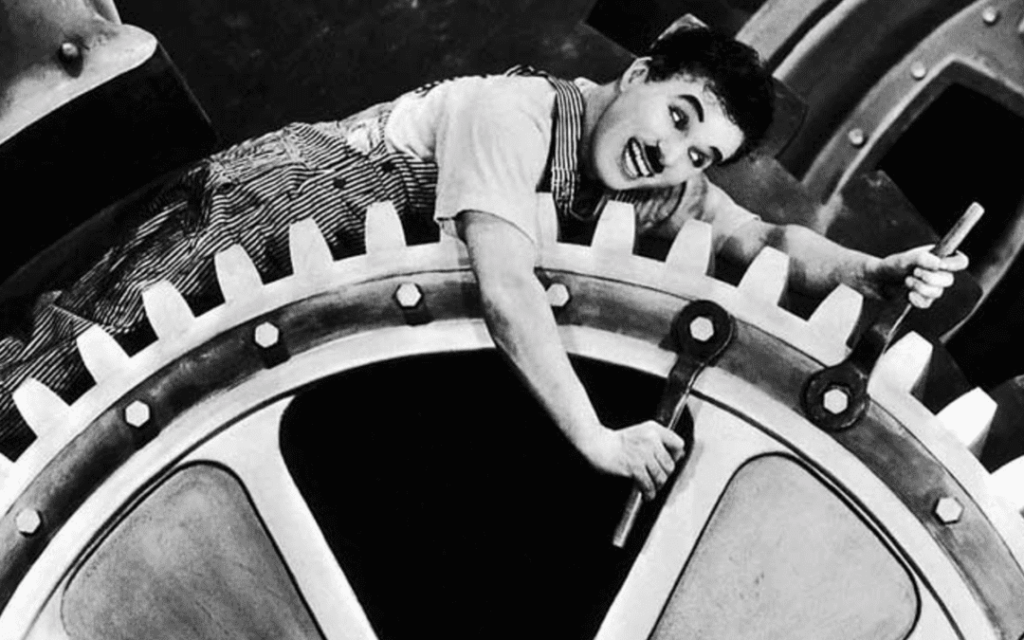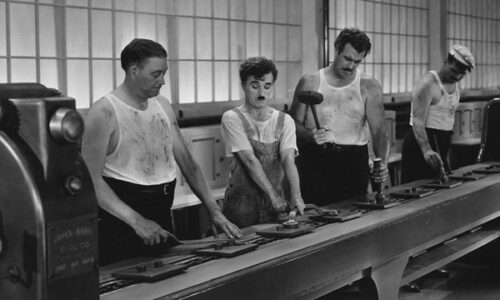The politics of sound, due to the tortures of visual judgment, implicitly plays a crucial role in forming the spinal narrative of the 1936 film ‘Modern Times’. With a symphonic proportion of 64 players, Charlie Chaplin wrote a musical saga of human ‘desire’ and its fatal ‘destiny’ where his music posited the audience on an ambient platform to make active agents and independent authors out of themselves. Thus, Chaplin begins with the note G played at Fortissimo, with a bit of vibrato. An unusual combination of F augmented scale beginning with the discordant G instead of the root note F loses its tonal center and creates a disturbing sound. In all its amplification, the note places the audience in a fearful state. In all its loudness and magnified dynamics, the trumpet resonates with the arrival of an ugly, monstrous giant. It marks the emergence of a powerful, dangerous, superhuman, disciplinary force that beholds the power within itself of destabilizing the regular, rhythmic harmony of human life. Fear of the unknown or unfamiliarity with the new brings an irregularity to the regularized motion of the everyday world. This unfamiliarity with the new order brings in a change-in-motion to the lives of the commoner compared to that of their previous state of existence. So, a nonrhythmic sequence of G, F, C#, and D# played at Fortissimo screams out like an alarming voice, and the added vibrato trembles the audience’s current bodily disposition, leaving him in utter chaos. This is how it roughly introduces the blueprint of a newly emerging order.
A sudden bass drum anvil. As if it hammers into our consciousness. And then the tune plays once again, but this time a little faster as it reintroduces the same order for us to recognize its rapidity. Now, two consecutive bass drum anvil accompanied by the trumpet, oboe, and the contrabassoon. As the judge shouts within a courtroom “order-order,” similarly, the anvil hammers into our consciousness for the bodies to slowly accustom to this newly introduced Order. This is the same tune he uses to orchestrate the outrage among the unemployed, angry mob. Or when the tramp is sent to a mental asylum.
The clock represents a cycle that is supposed to govern human lives for centuries to come. Chaplin, by switching between 3-4 different kinds of tunes in the main title scene, encapsulates different modes of human emotion into a single cycle by subscribing a constituent motion to each emotion. As the hand of the clock completes one cycle, it starts playing the same set of tunes, which operates in constant repetition. It is as if the history of mankind is driven by a constant principle, where human “desire” plays the chief architect. The first tune is succeeded by a chromatic tune when the clock covers a quarter of the cycle. This tune is played by transposing into various scales at respective intervals. The chromatic tune played in an ascendo-descending manner reverberates the shivering state of mind and the perplexity of movements that characterize Tramp’s struggle with an alien motive force constantly intruding into his life.
A herd of sheep and workers coming out of the subway and entering the factory is characterized by an A# Minor – D# minor sequence played in a cello and a viola at 147 BPM. Following the sonic parade, as the workers enter the factory and get located at their respective places of work, the background music dissolves into a mechanic hiss. Now, there are 2 – 3 things to be noticed. The worker walking towards the console, switching on the machine ( the rhythm in which he walks and the time when he pulls the trigger) and the time when the secretary places the glass of water on the table, and the president takes his medicine; all these activities happen in synchrony with the rhythm in which the background score played at 147 BPM, but, in complete silence. This is the motive force of production into whose motion every individual attunes himself. At 3:12 seconds, the rhythm elevates to 169 BPM as the speed of the machines is increased as per the president’s instruction. The tramp and the other fellow worker constantly struggle to cope with the increasing speed. According to Timothy Brook, “The tempo grows to such a kinetic frenzy that much of the culminating section is nearly unplayable by humans. This merciless metronome… intentionally set by Chaplin is so fragile (so on-the-very edge-of-collapse) that the listener is compelled to identify with the frantic Charlie on the verge of his mental breakdown.” (1)
It is interesting to learn how Chaplin orchestrated the lunch hour scene. It starts with an alarm and ends with an alarm. As soon as the first alarm rings at 1:04:09, The bassoon and the viola enter a 4/4 staccato rhythm, playing an alternate sequence together in a tempo strictly fixed at 178 bpm. After playing a single bar, the flute arrives with the chromatically sequenced tune, which is the second tune of the main title scene. Here, the tune slowly moves to and fro between C, B, A#, A, G#, and G in a reptilian manner, giving an insinuating imagery of its movements from one note to the other. The dense, thick, lower octave notes of the bassoon represent a fat, monstrous giant, and the thin, sharp, loud middle octave notes of the viola represent a sharp, strict, legislative apparatus that keeps constant vigilance on the activities of the flute-tramp. The tramp in this tune chromatically insinuates from one note to the other, exercising its formal freedom, remaining restricted within the pathways directed by the bassoon-cello synchrony. Both the tunes represent the master and the labor, respectively, and play together in a disciplinary fashion under the agreement of a rhythmic contract.
Chaplin’s music throughout the entire narrative keeps increasing its tempo with time, but there is a tune in which he doesn’t use any rhythm. He plays the tune every time Tramp meets Gamin after being released from prison. He plays the tune when the tramp manages to make some time for himself to smoke. The tune cries out the tramp’s voice and mournfully celebrates his power to exercise freedom, the pleasure of breathing in life to the soul, and the joy of practicing his own will against the master’s will. However, that phase ends immediately. Chaplin orchestrates the final scene with the same tune where the frequencies touched by the first shift between G major and G major 7th signifies a release of tension. A tension that might have arisen in switching between 2 different motions. 2nd shift is between A minor and E major, which reverberates the fatal destiny of human desire, which is both free and fettered at the same time. 3rd shift towards B major characterizes a suspension, a dissolution of this desire towards the ultimate vanishing point, but soon succeeded by a peaceful return to the mother scale G major accompanied by the root note G. It is the tune that represents the human who always wants to liberate himself and be free from any rhythmic shackle.
It is interesting to note that as the tune gradually moves towards the end, the trumpet sings along the final lines of the tune, amplifying the essence of humanity to a certain height, and hits note G at fortissimo. It starts with G at fortissimo in the beginning and hits up G at fortissimo in the end but at a higher octave. But in the beginning, G was accompanied by F augmented, and in the end, the same note is accompanied by G major. By transitioning the scale from F augmented to G major, Chaplin brings a tonal centrality to the tune. This tonal center or the root may give the audience a falsified sense of peaceful, happy settlement that celebrates the magnanimity of human and their desire. (The fear of and unfamiliarity with the new is now replaced by a desire for the new). An octave is a series of 7 whole notes, which is reached after a cycle. So this time, when the trumpet hits the same note with a similar amplification but an octave higher than that of the earlier, it seems wherever the human civilization leads us to, whatever order it settles down to, it is a manifestation of the human desire, where the desire itself will always aspire to pitch an octave higher to that of its manifestation. Thus, Chaplin’s narrative, in its starting and final tune, is placed in a tautological allegory.


